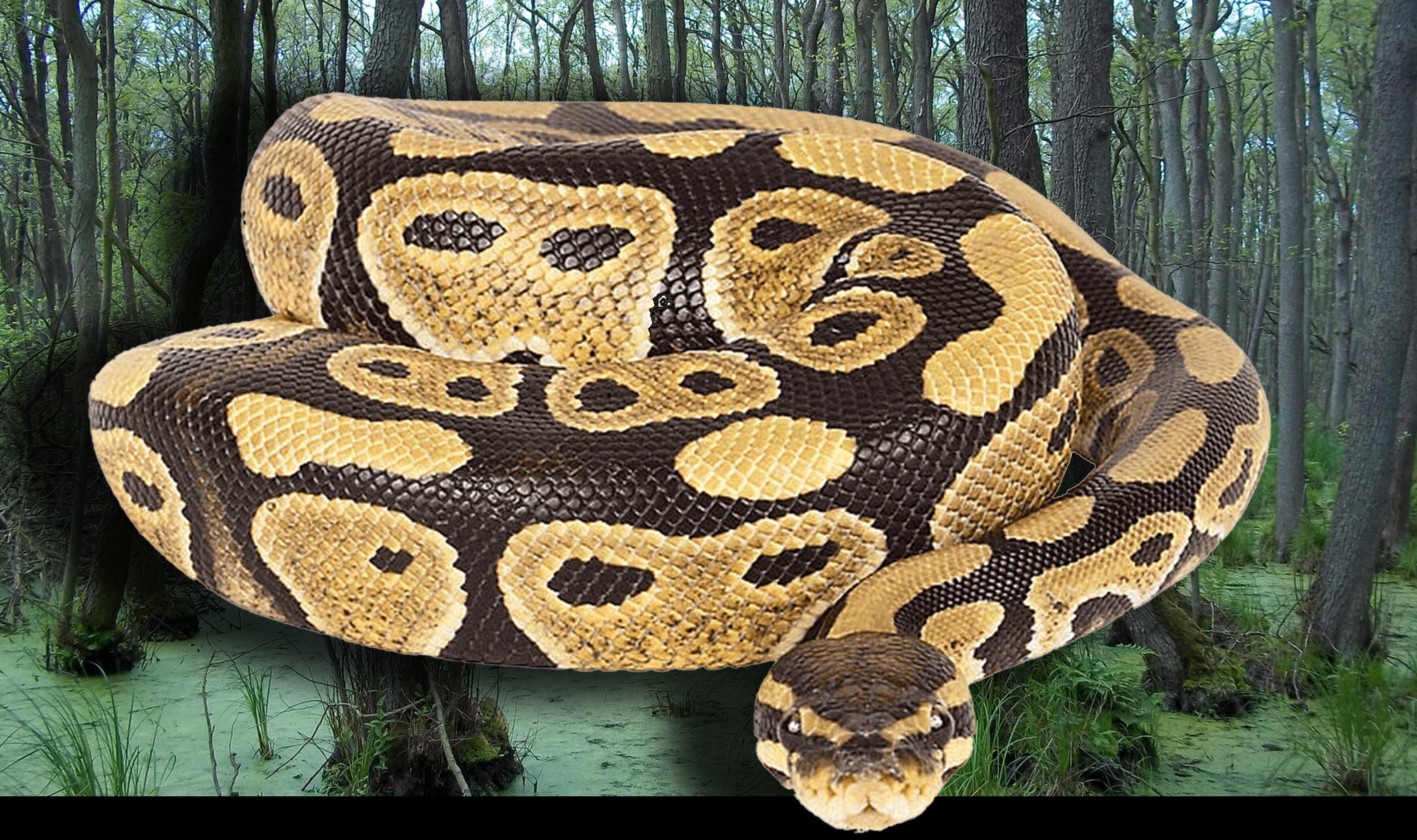A Frightening Problem in Florida: Wild Pythons
There are not supposed to be Burmese Pythons in Florida. Yet experts think there are anywhere from 30-150,000 of the large snakes living wild in the Everglades and some parts North. In this episode, we find out why there are so many pythons loose in Florida, what’s being done about it, then speak with Matt Dillahunty for the quick quiz!

Asking Google where the Burmese python is native to felt silly – kind of like asking someone, “When was the war of 1812?” But the python comes from more places than just Burma, otherwise known as Myanmar. They also are native to Northeastern and Southern China, Malaysia, Indonesia and throughout Southeast Asia. They used to be found in the Philippines as well, but aren’t there anymore.
You may have seen a Burmese Python in a zoo. They’re usually one of, if not the largest snake found in a zoo. They’re also a popular pet because of their impressive size, calm demeanor and due to the fact that they’re a non-venomous breed.
So, here are some facts about the snake: They’ll always want to be in a warm climate near water because they’re semi-aquatic, but they spend their early life in trees. They’re BIG snakes. The average length of a full-grown Burmese Python is around 12 feet, but there are records of some of them growing as large as 23 feet long. And they’re big fat boys too. Like as big around as a telephone pole – Some as big as 165 lbs. As far as appearance, they’re usually dark brown with beige blotches and on their head, they’ll have two lines that run across their eyes. So, brown, black and tan with spots and stripes on the head. You’ve seen one if you’re a big wrestling fan and remember Jake the Snake Roberts. Or if you remember Britney Spears famously handling a snake at the 2001 VMAs, that was an albino Burmese Python.
Since they’re non-venomous, the way they debilitate their pray is by constricting and wrapping around them. They squeeze, then swallow their prey whole. They hunt alone and eat a large variety of animals, from birds and rodents all the way up to pigs and deer. When people keep them as pets, they usually feed them mice, rats and small rabbits.
Burmese Pythons usually have around 40 eggs every year after their second year of life. They hatch after about 60 days and during that time of incubation, the mother creates warmth for the eggs by wrapping herself into a ball around them and making tiny little muscle movements to generate heat. When they’re born they’re only about 18” long and then they usually live 10-15 years in the wild and as long as 20 years in captivity.
A quick story: I used to work in a magic shop when I was a teenager and the owner had a pet Burmese Python. One thing you don’t want to do is get near it after its been fed. One time, the owner fed the snake and then soon after, reached into the snake’s habitat to change the water bowl and I watched this thing bite his hand. He was able to get free, but not before having a series of tiny pin-prick type wounds across his hand. Lots of pain – but luckily he was fine and the snake was okay too. Nonetheless, it was a pretty intimidating thing to witness. It struck FAST.
Until the late 1990s, you would only ever really see a Python in America if someone had it as a pet, or in a zoo. But that all changed due to a very surprising reason. And now some scientists say there are anywhere from 30,000 to 150,000 wild Burmese Pythons in Southern Florida.
Late August, 1992. Hurricane Andrew made landfall on Homestead, Florida – just South of Miami. It landed as a category 5 and was one of the most deadly, costly and largest hurricanes to ever hit Florida. It killed 65 people and caused $27 billion in damage.
As South Florida was struggling to rebuild, a story ran in the Fort Myers News-Press the next month. An animal trapper, Todd Hardwick had been called to a family home in Homestead. There was a 9 foot python near some bushes and 4 little girls, crying. The lump in the python was their family cat. At that point, there wasn’t much Hardwick could do for the family except capture the snake. He had spent the last month capturing all kinds of animals, wild, domestic and livestock. Thousands of horses, cows and pigs had gone loose when fences were destroyed. One facility had 3,000 monkeys being used for research. The hurricane had helped 200 of them escape. And there in homestead – a breeding facility for Burmese Pythons had been completely destroyed. All of the pythons escaped. 106,000 residents were still without power months later and all kinds of wild animals were roaming loose.
The subsequent hurricanes in Florida can be blamed as well. Any time homes and zoo habitats are destroyed, wild animals are let loose. That’s not to say that’s the only problem. People who buy exotic animals as pets are overwhelmed when they grow and we’ve seen many people release their animals into the wild for this reason. The pythons that were released in 1992 weren’t the first pythons found in the everglades. There are records of pythons being found in south florida as far back as 1977, but not on this scale. Certainly not on the scale large enough to breed and grow into a population in the 10s of thousands.
When a new invasive species is introduced to an area with a favorable climate, they usually thrive. The reason for this is they lack natural predators in this new environment. This was definitely true of the new Burmese Pythons in South Florida. The climate and environment of the Everglades is definitely hospitable to the snakes and their only real predator in the area are the alligators, but locals have also witnessed alligators falling prey to the pythons. The everglades is an area 734 square miles and filled with abundant animal life. Food for the snakes is plentiful. And that’s where we see one of the largest impacts of the new python population.
A huge decline in the small mammal population was observed over the next decade. In the everglades, 100% of the fox population was gone. 100% of the rabbit population. 99.3% of raccoons, 98.9% of the possums, 94.1% of the white-tailed deer and 87.5% of the bobcats. These animal populations were decimated. And it’s believed to be due to the ever-increasing number of Burmese Pythons. Some experts even believe the pythons are decreasing the numbers of the Florida Panther, which already has a conservation status of “critically imperiled.” The mammals in this area simply haven’t had a predator like a large snake. They know to be scared of alligators, but the last time a large snake like the Burmese Python roamed the everglades was 16 million years ago.
So there’s definitely a negative impact on other wildlife in the area, but what about people? Well in 2009, Florida saw an example of what happens when a Burmese Python gets loose around children. A python kept as a pet got loose and killed a 2 year old girl. And if the wild population of these snakes keeps growing, there is a real concern that these snakes will outgrow the wild area of the everglades and start living in South Florida’s more populated areas. Pets aren’t safe from a wild population of pythons. But if the python’s food source becomes depleted, they will get desperate and while they usually avoid humans, they’ll do what they need to in order to survive.
This is where this story echoes a couple other stories that we’ve featured. Namely, episode 95 about the Hippos in Colombia and episode 57 about the Cobras in Mumbai. Because the question becomes – what do we do about this growing Burmese Python problem? And is it a problem? There haven’t been too many run ins with humans. And due to the fact that the pythons can’t live in cold climates, they are sort of locked to the South Florida region. While they’re endangered in their native area, they’re thriving in the Everglades.
The government in Florida has actually allowed year-round permitless killing of the wild pythons. In 2012, 20 years after Hurricane Andrew, the Florida Fish and Wildlife Conservation Commission held a 30-day concentrated Burmese Python hunt. 1,600 people from 38 states participated in the hunt, and it only resulted in the killing of 68 snakes. Most of them were caught by the same 7 hunters who had experience in the area. Another hunt a few years later was called “The Python Challenge.” This time, just over 100 snakes were caught. As of 2018, only around 1,000 of the wild pythons had been killed. Remember – they think there are anywhere from 30,000 to 150,000.
Florida officials are lost as to ideas on how to solve this problem. They waited 20 years to really get serious about it, and now it’s just too late. It’s a problem for the local population, and for the local wildlife. As for the snakes? Well the snakes are doing just fine. The Internet Says it’s True.

Bonus episodes and content available at http://Patreon.com/MichaelKent
Review this podcast at https://podcasts.apple.com/us/podcast/the-internet-says-it-s-true/id1530853589
For special discounts and links to our sponsors, visit http://theinternetsaysitstrue.com/deals

